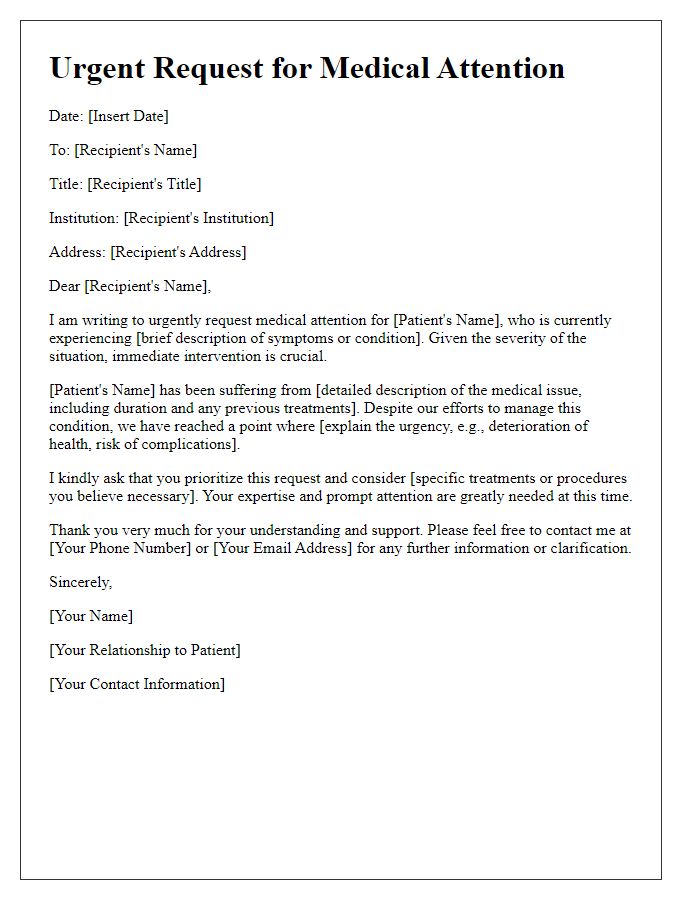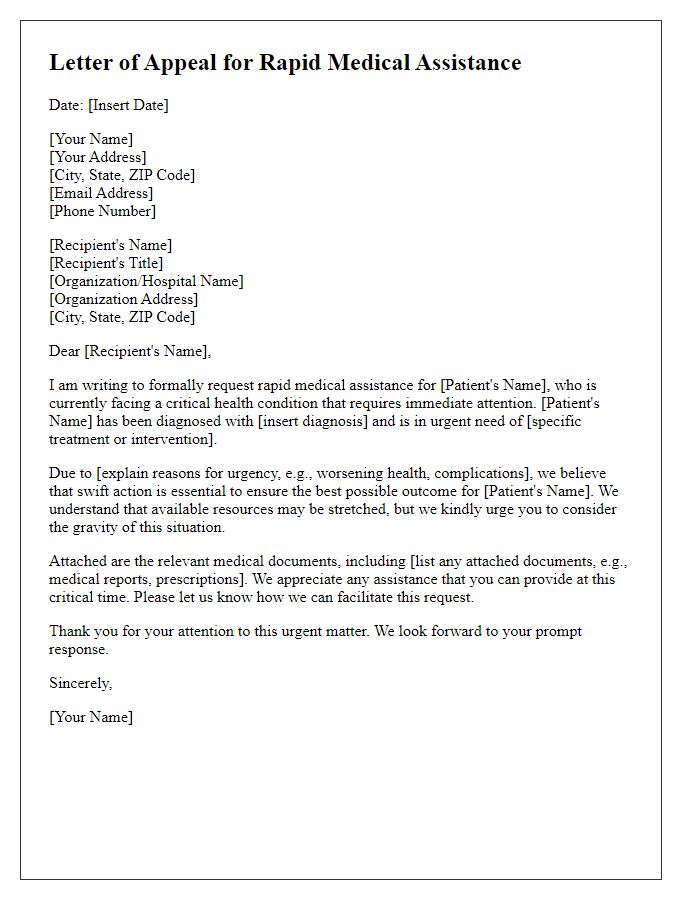When life throws an unexpected medical crisis your way, having a solid plan for emergency assistance can make all the difference. This letter template provides a structured approach to help you articulate your urgent needs clearly and effectively. By outlining crucial details such as symptoms, medical history, and the urgency of the situation, you can ensure that the request gets the attention it deserves. Ready to simplify your emergency communication? Read on for the full template and tips!

Urgency and specifics of the medical emergency
Emergency medical assistance regarding a severe allergic reaction can be crucial in saving a life. Symptoms such as difficulty breathing, swelling of the face and throat, and rash can escalate within minutes. For instance, an anaphylactic shock may occur rapidly after exposure to allergens like peanuts or bee stings, necessitating immediate intervention. Location plays a vital role; urban areas may have quicker access to ambulances, while rural regions may face delays exceeding 30 minutes. Specific information regarding the individual's medical history and allergies enhances the effectiveness of emergency responders, ensuring they provide appropriate treatment upon arrival. Quick action in these scenarios can significantly reduce risk of fatality or long-term complications.
Detailed patient information and medical history
In emergencies, rapid medical assistance is crucial for patient survival and recovery, particularly for individuals with complex health profiles. Comprehensive patient information includes the patient's full name, date of birth, and identification number, along with contact information for family members or caregivers. Relevant medical history should detail existing conditions such as diabetes, hypertension, or allergies, and current medications, including dosages and frequencies. Additionally, significant past medical events, surgeries, or hospitalizations can provide essential context for healthcare professionals, ensuring the delivery of appropriate care. For example, patients with a history of heart disease may require specific interventions during a cardiac event, emphasizing the need for detailed communication in emergency responses. Time-sensitive action can be facilitated through the inclusion of specific preferences or advance directives, providing clarity regarding the patient's wishes in critical situations.
Exact location and contact details
In emergency situations, the prompt provision of medical assistance is crucial for saving lives. Emergency medical services (EMS) dispatchers require exact location details for rapid response. Providing coordinates or specific street addresses ensures swift arrival of ambulances or medical teams. Contact details, such as mobile numbers or emergency contacts, facilitate communication for updates or further information. Maintaining clear access points, such as parking spaces for emergency vehicles, is vital at the scene. Implementing location markers, like landmarks or building names, aids first responders in navigating to the requested area efficiently. Always prioritize communication of any specific medical needs or conditions at the location to assist emergency personnel.
Required medical equipment or specialist care
Urgent requests for emergency medical assistance often involve specialized medical equipment or expert care tailored to critical health conditions. Medical equipment such as ventilators, defibrillators, or IV therapy supplies may be necessary for patients suffering from severe respiratory distress, cardiac arrest, or dehydration. Additionally, access to specialist care, such as cardiologists, pulmonologists, or trauma surgeons, is vital in emergency situations. Hospitals like Johns Hopkins Hospital or Mayo Clinic, renowned for their advanced medical technology and specialist availability, play a crucial role in handling these urgent cases. Rapid provision of these resources can significantly affect patient outcomes, underscoring the importance of a prompt and efficient response in emergencies involving critical health needs.
Requested timeframe for assistance
Emergency medical assistance is crucial in life-threatening situations, requiring prompt action. The timeframe for assistance should ideally be immediate, with emergency response teams arriving within minutes (typically 8-10 minutes for urban areas). Access to advanced life support systems and trained paramedics significantly impacts patient outcomes. Rapid assessment and intervention during critical moments can lead to increased survival rates, especially in cases such as cardiac arrest or severe trauma. Clear communication with emergency services can expedite the response, ensuring that appropriate resources are sent to the location, which further improves the efficacy of the assistance provided.













Comments